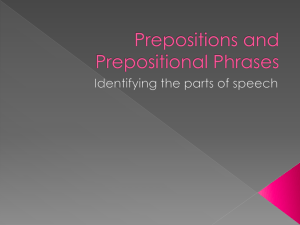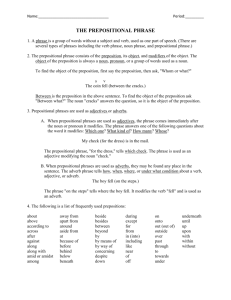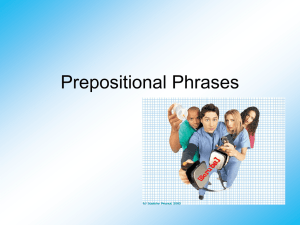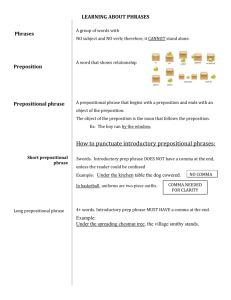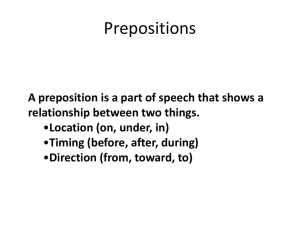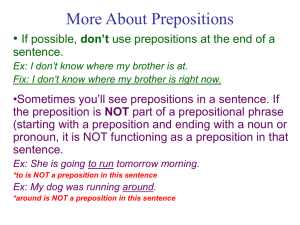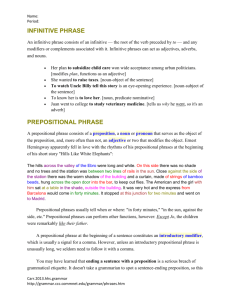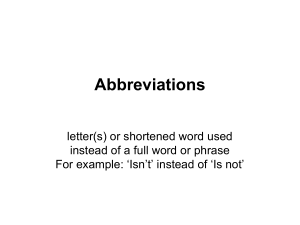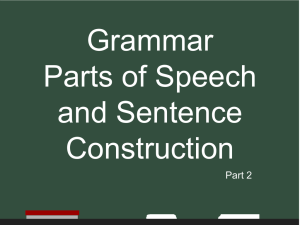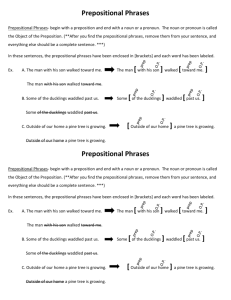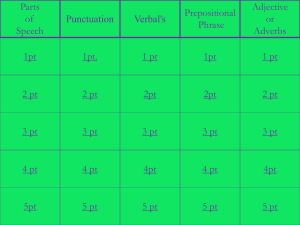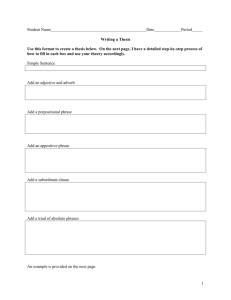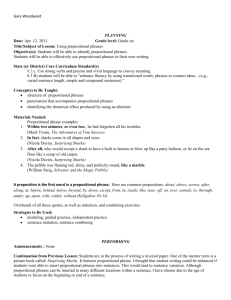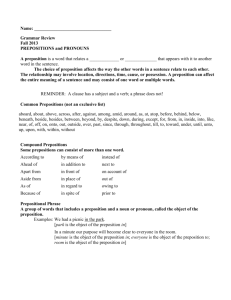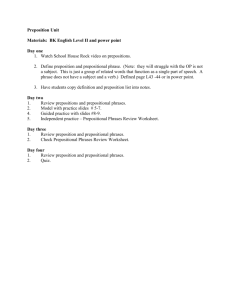File
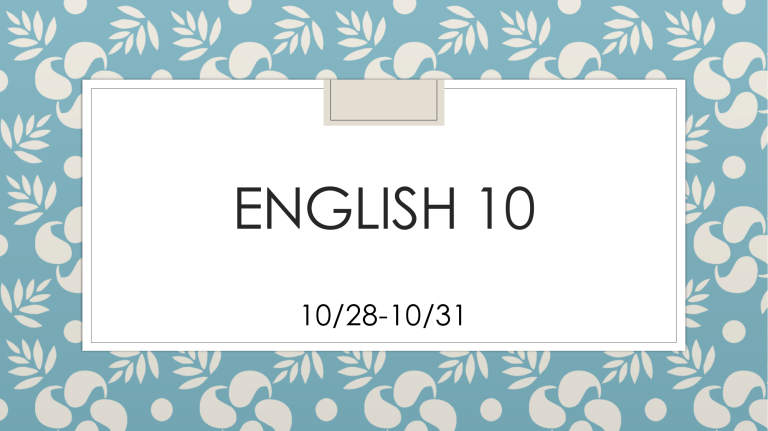
ENGLISH 10
10/28-10/31
Bell Ringer-Notes (Begin as soon as you come into class please).
◦ An appositive is a word placed after another word to explain or identify it.
The appositive always appears after the word it explains or identifies. It is always a noun or a pronoun, and the word it explains is also a noun or pronoun.
◦ ex. My uncle, a lawyer, is visiting us.
◦ My teacher, Miss Marshall, is very strict.
◦ An appositive phrase consists of the appositive and its modifiers which may themselves be phrases.
◦ ex. My radio, an old portable, is in the repair shop.
◦ The boys climbed the mountain, one of the highest in the West.
Poetry Analysis Essay
◦ Write a five paragraph essay analyzing how
Robert Frost in “Into My Own” uses a forest to symbolize the quest for independence and selfawareness. Each paragraph should be approximately 5-7 sentences. Use at least two pieces of textual evidence to support each body paragraph.
◦ 1 st Draft Due Monday!
Homework: Poetry Analysis Thesis
Statement
◦
In your thesis, identify the literary element(s) to be analyzed and the approach or direction of the analysis.
◦
What message is the poem sending?
◦ Example Formula: Robert Frost in “Into My Own” uses a dark forest to symbolize the quest for independence and self-awareness.
◦ (Please come up with something more unique, specific, and sophisticated.)
Poem Analysis
1.
Go back an identify any of the following elements in the poem.
Figurative language (simile, metaphor, irony etc.)
Imagery
Repetition
Allusion/Symbolism
Tone/Mood
Rhyme
Theme
Bell Ringer-Prepositional Phrases
(Write out sentences in notebook-more than one in each sentence!)
1. Many people are intolerant of opinions and actions which do not confirm to their ideas of appropriate behavior.
2. From this experience, I have learned my lesson about the dangers of telling lies.
3. The children danced around the pole until the song came to an end.
4. We ran toward the barn when the storm broke from the clouds.
5. The trail that winds up the mountain leads to the top of the ridge near the edge of the cliff.
Agenda
Bell Ringer- Prepositional Phrases
Turn in Progress Reports & Missing Work
*You must see me during my “office hours” if you need extra help, something printed or just have a question about your grade.
-Before School
-After School
-4 th Period
-6 Th Period
Agenda Continued
◦ Explicate “Into My Own”
◦ Poetry Free Write-Write for 5 minutes concerning what you think this poem is about.
◦ Homework: Complete a thesis statement for an analysis of “Into My Own”
Different types of phrases
◦ A phrase is a group of words without a subject and verb, used as one part of speech.
◦ (There are several types of phrases including the verb phrase, noun phrase, and prepositional phrase.)
Prepositional Phrases
◦ The prepositional phrase consists of the preposition, its object, and modifiers of the object.
◦ The object of the preposition is always a noun, pronoun, or a group of words used as a noun.
◦ To find the object of the preposition, first say the preposition, then ask,
"Whom or what?"
◦ The coin fell (between the cracks.)
◦ Between is the preposition in the above sentence.
◦ To find the object of the preposition ask "Between what?" The noun
"cracks" answers the question, so it is the object of the preposition.
Prepositional Phrases
◦ Prepositional phrases are used as adjectives or adverbs.
◦ A. When prepositional phrases are used as adjectives, the phrase comes immediately after the noun or pronoun it modifies.
◦ The phrase answers one of the following questions about the word it modifies: Which one? What kind of? How many? Whose?
◦ My check (for the dress) is in the mail.
◦ The prepositional phrase, "for the dress," tells which check.
The phrase is used as an adjective modifying the noun
"check."
Prepositional Phrases
◦ When prepositional phrases are used as adverbs, they may be found any place in the sentence.
◦ The adverb phrase tells how, when, where, or under what condition about a verb, adjective, or adverb.
◦ The boy fell (on the steps.)
◦ The phrase "on the steps" tells where the boy fell.
It modifies the verb "fell" and is used as an adverb.
Frequently used Prepositions-you do not have to write these down.
◦ about away from beside during on underneath
◦ above
◦ According to
◦ across
◦ after
◦ against
◦ along
◦ along with
◦ amid or amidst
◦ Among apart from besides around at before behind below beneath between aside from beyond by despite of towards down except for out from in (into) off under onto until out of up outside upon over with because of by means of including past within by way of like concerning near through without to
Since there is no help
◦ Speaker is male and he and his beloved are breaking off their relationship.
◦ He asserts positively that he does, but in the first octave asserts that he is acting under constraint. “Since there’s no help.”
◦ This suggests that any future meetings may be difficult because they will have trouble disguising their still-existent feelings for each other.
◦ If any doubt remains that he does not really want to break off the relationship, it is dissolved by the sestet.
◦ The true feelings lie in the allegorical and poetic language of the sestet.
◦ Does she want to break off the relationship?
◦ “Nay” is a clear signal that this line is spoken in response to some gesture or word of protest made by her against his pronouncement in line 1. She does not want to kiss and part.
Since there is no help
◦ But if neither wants to break off the relationship, why are they breaking it off?
◦ Allegorical death scene depicted in the sestet.
◦ Death of Love and Death of Passion (Spiritual and Physical aspects)
◦ Prounouns (his & him) suggest that it is his love & passion that dies.
◦ The logic of the situation suggests that the two attendants at the bedside, Faith kneeling in prayer, Innocence pulling down the eyelids of the presumably dead figure, are hers.
Her innocence is closing up the eyes of his passion; her faith (religious scruple) is assisting at the bedside.
◦ He asserts if she would, she might at the very moment of death bring his love/passion back to life.
◦ The woman wishes to retain his love, she also values and wishes to preserve her innocence (purity & chastity).
◦ He claims that, by refusing to satisfy his passion, she is causing both it and his love to die.
